
Europe and Mediterranean: Aegean Wonders
Regent Seven Seas Cruises
Steeped in Greek mythological history, Mykonos was named after Apollo's grandson, Mykons, and was the location of the grand battle between Zeus and the Gigantes. Today, this island is one of Greece's most adored destinations due to its picture-postcard setting and growing nightlife. Mykonos is a superb example of Cycladic architecture, and by law even new buildings have to be built in the same style of whitewashed, organic, cube-like buildings.

All-Inclusive Cruise
All onboard gratuities
Select complimentary shore excursions**
Unlimited beverages, including fine wines and premium spirits served throughout the ship
In-suite refrigerator replenished daily with soft drinks, beer and bottled water
24-Hour room service
No charge for specialty restaurants
Welcome bottle of Champagne
$100 Shipboard credit per suite††
Executive Member Benefit
Executive Members receive an annual 2% Reward, up to $1,250, on qualified Costco Travel purchases
Executive Members receive an additional $100 shipboard credit per suite (not combinable with certain past-guest discounts)††
Digital Costco Shop Card
Member Exclusive: Digital Costco Shop Card with every Regent Seven Seas Cruises® sailing†
Sailing Itinerary

Note: Cruise itineraries are subject to change. Please verify ports and times directly with the cruise line.
Overview
Today Piraeus is the home base of Greek shipping, the largest commercial fleet in the world, apace bound to the sea like few others. The harbors of Zea and Mikrolimano as well as Phaliro play host to countless yachts and sailing craft throughout the year. Piraeus was known in medieval times as Porto Leone, a name due to the enormous stone lion, which guarded the port's entrance. Today, the life of Piraeus is centered on its three ports: the main, central one, and those of Zea and Mikrolimano. You can walk around the central harbor, shared by cargo and passenger ships alike, and watch the constant comings and goings of goods and people from around the world. Having completed your tour of the central harbor of Piraeus you will then head south traversing the peninsula and arriving at Peiraiki, one of the most picturesque neighborhoods in the city. Here one finds the harbor of Zea, one of the largest marinas in the Mediterranean. If the night finds you in the area, you can try one of the many bars found nearby. You can continue your tour along the waterfront heading towards Kastella but a small deviation toward the city center will be useful for then you can visit the verdant square of the municipal Theatre with cafeterias and shops of all kinds surrounding it. The magnificent building housing the Municipal Theatre as well as the Town Hall and the Library complete the picture presented by the main square in the city. Piraeus's little natural harbors are among its busiest and most touristy areas: Mikrolimano, Passalimani, Zea, Freatida, and Hatzikiriakio. Countless seaside tavernas provide delicious seafood washed down with the uniquely Greek drink, ouzo. The fresh smell of the sea and the sounds made by the assortment of caiques, yachts, and sailing ships, which are moored next to the tables, complete the enjoyment of the food Beyond the port, the most impressive spots are the hills of Profitis Ilias and Kastela with their neoclassical mansions and modern buildings which look as they are hanging over the sea.
Overview
The City of Split marks 1700 years since the beginning of the construction of Diocletian's Palace. Split, a city where every epoche since antiquity has left its traces, was conceived within the walls of the palace which was built by the Roman Emperor Diocletian as his private residence. The well-preserved palace has been listed as UNESCO's register of the world's cultural heritage. During these 1700 years, Split has played an important role in Croatian history. Today, Split is the center of cultural and scientific life, with many institutions, museums, galleries, and theatres. Split is the second biggest city in Croatia. Due to its central position on the Adriatic coast and its exceptional environment, Split soon developed into the leading and biggest city of South Croatia, its large port, commercial and industrial center, and an important European tourist resort. The present city of Split is an organic fusion of its antique heritage and modern architecture, set up in a beautiful Mediterranean environment and full of the sober and thoughtful atmosphere of a big city. As the scientific center of the region, Split's scientific institutions have had remarkable results in many fields including the protection and study of cultural and natural heritage, oceanography, fishery, Adriatic agricultural cultures, etc. Split is also known for great accomplishments in sports, notably basketball, soccer, tennis, handball, rowing, sailing, and water polo. Split hosted the Mediterranean Sports Games and the European Athletic Championships. Split is connected by rail to the hinterland, by ferry boats to the Adriatic islands, Italy, and Croatia, and the rest of the world by its international airport.
Overview
Iraklion is the capital of Crete and of the prefecture of Iraklion. It is easily accessible from Athens by at least four flights a day. There are international flights from Iraklion to Frankfurt and Amsterdam. Between April and October, there are charters from many other European cities. Iraklion is a very busy city, especially during the tourist season, so it is advisable to book reservations for accommodation before arrival, especially during August. If you are traveling by car there are parking lots near the end of Kalokairinou Street at the Chanioporta and below the Archaeological Museum, one of the many uses of a medieval moat. Make use of them and take the opportunity to see the historical monuments. As you walk up 25 August (Odos 25 Avgoustou) Street you will see numerous agencies advertising tours of all kinds. Santorini, Rhodes, and Mikonos are some of the most visited islands. You can also arrange tours of Knossos, Festos, Gortyn, and the Samaria Gorge. Most of the offices are professional and offer good value. However, to avoid confusion and disappointment, pay attention to the details of the trip, such as the time of pick up, time of arrival at the site, time spent at the site, and entrance fees; these may sometimes be vague. The National Road is easily reached from Iraklion. You can drive to Agios Nikolaos in 1 hr (72km) and Chania in 2 hours (137km). This road is enjoyable and the scenery is spectacular. Drive with caution on all roads in Crete. All means of transportation, including donkeys, farm equipment, and tour buses use the roads at varying speeds. These facts are not truly understood by many of the tourists or even the locals. Iraklion is the fifth largest city in Greece and there has been a settlement here since Neolithic times. Although few remains have been found in the city proper, it was probably a port for Knossos during Minoan and Roman times. The Saracens captured it in 824 A.D. and renamed it El Khandak (The Moat) after the moat they dug around it. The city was regained by the Byzantine Empire in 961 A.D. after many unsuccessful attempts. After the Crusaders occupied Constantinople in 1204, they gave Crete to Boniface of Monferrat who sold the island to Venice for one thousand pieces of silver. Under Venetian rule, the arts flourished, and “Candia”, as the Venetians renamed it, became a center of learning. Many scholars and artists took refuge in Candia after the fall of Constantinople in 1453. The Venetians began construction of the city walls in 1462, which were completed more than a century later. The walls were 4km in length, of a triangular shape, and had seven bastions. The Venetians also built the harbor and various other masterly architectural works. The walls proved their deterrent strength when the city was besieged for 21 years, one of the longest sieges in history. The final surrender came in 1669 after 100,000 Turks and 30,000 Venetians had been killed. Turkish occupation was heavily resented by the Cretans and continuous guerrilla warfare was waged against the Turks and, in return, the Turks often made reprisals against the Cretan population in the cities. Iraklion grew in size after the 1913 union with Greece. However, its strategic location again made it a target for invading forces in 1941. The German bombardment during the Battle of Crete caused a great amount of damage and after the war, the city was extensively rebuilt. Chania was originally the capital of Crete. The administrative center of Crete was transferred to Iraklion in 1971.
Overview
Mykonos is world-famous. It is no coincidence that this, the most cosmopolitan of all Greek islands, attracts so many visitors from all over the globe, including large numbers of artists and intellectuals. Here, the steep mountains to be encountered in most of the Cyclades give way to low, rocky hills which combine with superb beaches to make up the landscape of the island. The capital, Hora (Chora), with its colourful harbour in which little fishingboats nestle happily side by side with luxury yachts, presents quite a different picture from the majority of Aegean island towns. While it is usual for island villages to be built on naturally amphitheatrical sites, Mykonos is spread out over a flat area and conveys an impression of lid aesthetic cohesion. Along the whitewashed streets stand brilliant white box-shaped houses with stepped walls for sitting on, wooden doors and windows and brightly-coloured balconies. These are interspersed with small but impressive churches, pretty little tavernas and shops selling souvenirs and other goods, and the overall sense is of being inside a film set. On the low Kastro hill is the complex of churches known collectively as Our Lady 'Paraportiani', a superb arrangement of whitewashed masses created over the centuries and now recognised as a national cultural monument. Of particular historical and aesthetic interest are the medieval houses in this district of the town, which stand like a wall above the sea protecting the west side of Hora. The Archaeological Museum of Hora contains finds from tombs on the nearby island of Rhenia, sculptures, vases and figurines. The Folklore Museum brings together a number of collections of furniture, icons, pieces of sculpture and folk musical instruments. Mykonos is also the home of the Nautical Museum of the Aegean, which has interest all of its own. The countryside of Mykonos is a mixture of grey-green rocks ringed by prickly pear plants and little fertile areas carpeted with wild flowers. Here and there are tiny whitewashed chapels and windmills. Ano Mera is, after Hora, the most important of the older villages on the island. Standing 8 km. to the east of the town, Ano Mera has the interesting monastery of Our Lady Tourliani, ornamented with fine wood-carvings. The church has a collection of valuable ecclesiastical vessels, vestments and embroideries. The courtyard contains an interesting bell-tower and a marble fountain. Here lovers of the sea will find outstanding golden beaches such as Agios Stefanos, Psarou, Kalafatis, Platis Gialos, Ornos, Elia and Panormos. Miykonos is a busy island with all the amenities of a modern resort and with plenty to do - by day or night for those who want to have a lively time. Yet visitors fond of more peaceful holidays will still find quiet corners in which to relax.
Overview
This seaside resort town has grown immensely in the last 30 years and is especially popular with package holiday-makers from Europe. From a population of 6000 in the 1970s, it is now closer to 50,000, although a high proportion of this is part of the tourist industry and here only for the summer. Many cruising ships traveling around the Aegean Islands stop here, especially because of its proximity (20km) to Selcuk. Kusadasi is a good base to explore this and other ancient cities like Priene and Didyma. Although there is little historical interest in Kusadasi itself, the town is popular predominantly because of its many hotels, restaurants, souvenir and carpet shops, and lively nightlife. The Kale district has some old traditional houses and narrow streets which gives some indication of what the town used to be like. The most famous beach is Kadinlar Plaji, 2.5km south of the town, dominated by huge hotels, and can get very crowded in summer. There are several small beaches further south, and closer to town is Yilanci Burnu, the peninsular.
Overview
Mytilini is not a town. It's a city. But it is an amazing little city full of life and surprises and if you are someone with a long history in Greece it may remind you of Athens or Pireaus in the fifties. Like other great cities, Mytilini is built upon seven hills and is full of history. Mytilini is one of the most culturally enlightened cities in Greece perhaps due to its proximity to the coast of Asia Minor where the ancient Greeks flourished until 1922 when they were forcefully evicted by the Turks. Many of these Greeks had property in Mytilini and many Mytilinians had businesses in Asia Minor. For this reason, the museums are full of interesting remnants of the last three thousand years of history and the town itself contains monuments, houses, churches, schools, and other buildings from the various historical periods. But it is the Mytilini of today that holds the most interest for many because it is a small and manageable city full of great restaurants, cafes, nightlife, and friendly, intelligent people. When you arrive by boat at 7 in the morning it is quiet. The city spreads from the large harbor up into the hills behind it and is crowned by an enormous castle whose foundations were laid during the time of Justinian on the ruins of an even more ancient fortification. This castle is surrounded by a pine forest that reaches down to the shore and the public beach. In the summertime,e the castle is used for performances of traveling groups of musicians, theater, opera, and music and art festivals. It is one of the best places to hear a concert in Greece. The castle is well worth a trip and a walk around the promontory will give you a whole new perspective of the city because it is like being out in the wilderness with horses and donkeys grazing on the hills that lead up to the fort. If you continue to the back side of the city you will come to the old bordellos and the old harbor. The waterfront comes alive with traffic by 8 and stays that way until just after 1 pm when the stores close and everyone goes home for lunch and siesta. By early evening the city is alive again with activity. This is not your typical quiet Greek island village but it is certainly a very entertaining place. The main street is lined with cafes that seem to be full year-round. For the rest of the island, Mytilini is the big city. Smaller villages send their children here for high school. People come from all over the island to do their shopping since there are supermarkets in the true sense of the word, with aisle after aisle of products, imported and domestic. There are cultural activities, concerts of all styles of music, basketball tournaments, an indoor swimming pool, and of course the city is the center of the island Government, not only for Lesvos but for Lemnos too. The marketplace is one of the most active in Greece with shops of every variety and closed to automobile traffic while the stores are open. There is ample evidence of the plentiful fish in Lesvos waters and prices are low. When I arrive by ferry in the early morning I usually spend an hour or so wandering around, checking out the fish and buying sardines pastes or pastrami (dried spiced beef-like pastrami) to bring as gifts to my friend Tryphon to serve with ouzo in his cafe neon on the far side of the island. It is hard to imagine a more interesting way to spend a morning and the shops contain a variety of items that you won't find anywhere else and to me are more entertaining than a museum. If you require strong coffee tetgog to the small traditional-looking cafe right across the street from the yogurt shop (that has the best yogurt in the world). It is called the Musico Cafeneon and it is on the corner of Komninaki Street. If you are just getting off the boat it is a great place to gather your thoughts and drink an espresso or two. The owner is a woman named Martina and she or one of her staff can answer any questions you have upon arrival. If you are staying in the city, day or night it is a great place to hang out.
Overview
Istanbul is an international art and cultural center. The International Arts and Cultural Festival is held each year in June and July with famous artists coming from all over the world. These performances are held mostly at the Ataturk Cultural Center. Those who enjoy classical music can hear it at the Cemal Resit Rey Hall. Operas, operettas, ballets, films, concerts, exhibitions, and conferences all contribute to the cultural palette of the city. Istanbul also has a rich program of light entertainment. Nightclubs provide splendid entertainment throughout dinner, ranging from a selection of Turkish songs to belly dancing. Istanbul is a preferred city in terms of international art activities. This is because the art lovers of Istanbul are respectful of the art and the artist. The famous performance artists feel very comfortable in Istanbul concerts. Because the audience is very well aware of "the ritual of watching an artistic performance." The artist knows that he or she will not come across with impudent or disrespectful behaviors. It is the same for international picture galleries, biennials, and visual activities. Neither the spectator nor the critic leaves their "respectful attitude against the artist. " Hence the myths of traditional pop-rock genres, giants of jazz, and contemporary legends of classical Western music are always in Istanbul, on the stage. To sum up; Istanbul is a city that can add compassion next to its giant size in terms of living area and population, and try to assimilate the universal culture while "welcoming" it with utmost hospitality: a "world city" In this case, it deserves to be called "universal culture capital"
Overview
Istanbul is an international art and cultural center. The International Arts and Cultural Festival is held each year in June and July with famous artists coming from all over the world. These performances are held mostly at the Ataturk Cultural Center. Those who enjoy classical music can hear it at the Cemal Resit Rey Hall. Operas, operettas, ballets, films, concerts, exhibitions, and conferences all contribute to the cultural palette of the city. Istanbul also has a rich program of light entertainment. Nightclubs provide splendid entertainment throughout dinner, ranging from a selection of Turkish songs to belly dancing. Istanbul is a preferred city in terms of international art activities. This is because the art lovers of Istanbul are respectful of the art and the artist. The famous performance artists feel very comfortable in Istanbul concerts. Because the audience is very well aware of "the ritual of watching an artistic performance." The artist knows that he or she will not come across with impudent or disrespectful behaviors. It is the same for international picture galleries, biennials, and visual activities. Neither the spectator nor the critic leaves their "respectful attitude against the artist. " Hence the myths of traditional pop-rock genres, giants of jazz, and contemporary legends of classical Western music are always in Istanbul, on the stage. To sum up; Istanbul is a city that can add compassion next to its giant size in terms of living area and population, and try to assimilate the universal culture while "welcoming" it with utmost hospitality: a "world city" In this case, it deserves to be called "universal culture capital"
Onboard the Seven Seas Voyager
Seven Seas Voyager
Year Built: 2003
Year Refurbished: 2016
Double Occupancy Capacity: 700
A trailblazer in the exclusive world of all-suite, all-balcony ships, Seven Seas Voyager® exceeds even the loftiest expectations for luxury. Considering her size, the amenities are surprisingly plentiful and include four main dining venues where you can dine wherever, whenever and with whomever you choose. With 447 international crew members attending to a maximum 700 guests, personal service is exceedingly indulgent throughout.
Activities & Services (included in cruise)
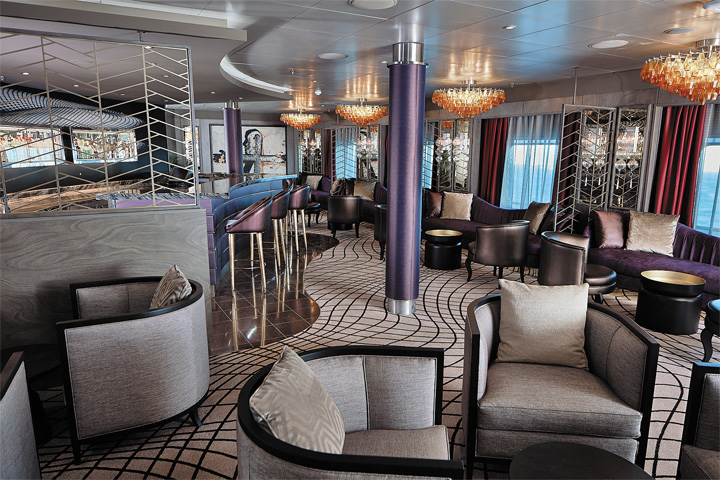
Lounge
- Card Room
- Disco/Nightclub
- Movies
- Fitness Center
- Sauna/Steam Room
- Educational Programs
- Pool - Outdoor
- Sports Facilities
- Whirlpool/Jacuzzi
- Bars/Lounges
- Library
- Wi-Fi
- Organized Age Specific Activities
- Teen Programs
- Business Center
- Concierge Desk
- Dry Cleaning/ Laundry Service
- Duty-Free Shops/Boutiques
- Elevators
Activities & Services (available for an extra fee)
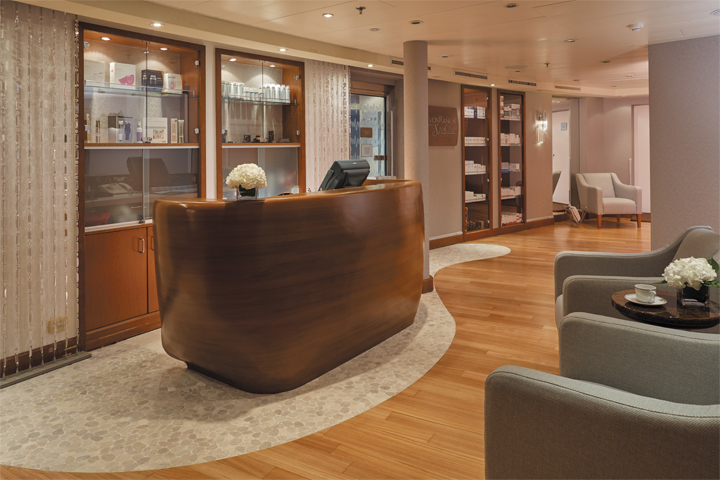
Full-Service Spa
- Beauty Salon
- Full-Service Spa
- Infirmary/Medical Center
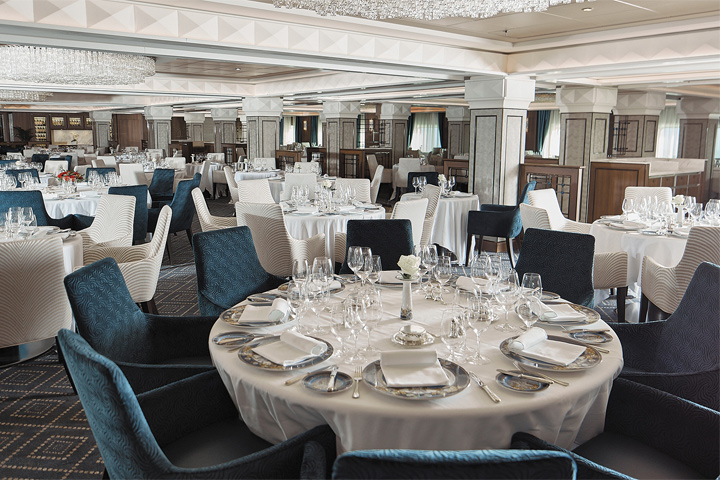
Compass Rose
Specialty Dining
Chartreuse: Featuring a classic French menu with a modern twist, Chartreuse evokes memories of a chic Parisian fine dining restaurant discovered during an evening stroll. Wherever you are seated in this regal restaurant, you will be treated to a succulent dinner while enjoying incredible ocean views. The restaurant ambiance is complemented by a menu that features dishes expertly prepared using both classic and modern techniques for a multiple course celebration of French gastronomy.
Compass Rose: Much thought was given to the design of Compass Rose, the flagship restaurant of Regent Seven Seas fleet. The dining room is outfitted with rich woods contrasted by light marble stones and mother of pearl shimmering brightly with an elegant color theme of light shades of blue, white, gold and silver. Compass Rose delights with a beautifully defined atmosphere and transitions from refreshing natural light during the day to a romantic ice blue lighting theme at night. This is the perfect setting for you to enjoy your breakfast, lunch and dinner, where the menu features an exceptional variety of Continental cuisine.
Prime 7: A true classic in every sense, Prime 7 sets a new standard in steakhouse fare with its contemporary interpretation of an American favorite. Handsomely decorated with supple leather wing-back chairs, burnished woods and rich earth-toned fabrics, Prime 7 exudes a distinct, intimate elegance. All the traditional starters are here, including Jumbo Lump Crab Cakes, Classic Steak Tartare, and Clam Chowder. Of course, beef is the undisputed star, and it is all USDA Prime and Dry-Aged at least 28 days to ensure the ultimate tenderness, juiciness and flavor. Prime New York Strip, Porterhouse Steak and succulent Filet Mignon only touch upon the selections. Mouthwatering alternatives include Alaskan King Crab Legs and Dover Sole. Prime 7 is open for dinner only and reservations are required.
Sette Mari at La Veranda: Each evening, La Veranda transforms into Sette Mari at La Veranda, a casual, intimate dining experience. Enjoy an extensive menu of authentic antipasti and Italian specialties served á la carte and paired with fine Italian wines — complimentary of course. Delectable dishes are prepared á la minute by talented chefs using only the freshest gourmet ingredients and served by attentive waiters. Sette Mari at La Veranda is open for dinner only.
Casual Dining
La Veranda Restaurant: Take in stunning ocean views while enjoying elegant breakfast and lunch buffets in the chic indoor dining room or al fresco on the shaded, open-air deck. Breakfasts include traditional favorites, as well as a made-to-order omelet station, a variety of fresh fruits and pastries, along with daily specials, like fluffy Belgian waffles with fresh blueberry compote. For lunch indulge in an array of choices from a bountiful salad bar, gourmet sandwiches, hot carving stations and delicious desserts.
Pool Grill: The Pool Grill is open-air, yet abundantly shaded for comfortable dining. Enjoy grilled-to-order burgers, grilled seafood, sandwiches, and fresh salads. Treat yourself to milkshakes and malts or an old-fashioned hand-dipped ice cream dessert sprinkled with all your favorite toppings.
Room Service: Complimentary 24-hour dining in the comfort of your stateroom.
Features a European king-size bed, a sitting area, a marble bathroom, a walk-in closet and a balcony. Concierge Level is available.
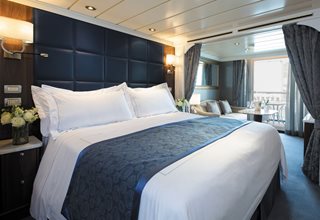
Category: H
Every inch of this suite has been thoughtfully designed to maximize interior space and embrace the magnificent scenery outdoors. From the sitting area, admire the ocean views through the floor-to-ceiling windows, or better yet, take a seat outside on your private balcony to watch the world go by. Elegant finishes such as luxurious bedding and beautiful marble detailing in the bath further enhance your comfort.
Suite size: 28.4 m²
Balcony size: 4.7 m²
Amenities:- Unlimited Wi-Fi Includes Two Logins, Two Devices, per Suite
- Valet Laundry Service
- Customizable In-Suite Mini Bar Replenished Daily with Your Preferences
- Welcome Bottle of Champagne and Fresh Fruit
- 24-hour In-Suite Dining
- Fresh Orchid Arrangement
- L'Occitane® Jasmin & Bergamot Bath Amenities
- Regent Plush Bathrobe and Slippers
- Interactive Flat-Screen Television and Direct-Dial Satellite Phone
- Vanity and Hair Dryer
- Shoe Shine Service

Category: G
Every inch of this suite has been thoughtfully designed to maximize interior space and embrace the magnificent scenery outdoors. From the sitting area, admire the ocean views through the floor-to-ceiling windows, or better yet, take a seat outside on your private balcony to watch the world go by. Elegant finishes such as luxurious bedding and beautiful marble detailing in the bath further enhance your comfort.
Suite size: 28.4 m²
Balcony size: 4.7 m²
Amenities:- Unlimited Wi-Fi Includes Two Logins, Two Devices, per Suite
- Valet Laundry Service
- Customizable In-Suite Mini Bar Replenished Daily with Your Preferences
- Welcome Bottle of Champagne and Fresh Fruit
- 24-hour In-Suite Dining
- Fresh Orchid Arrangement
- L'Occitane® Jasmin & Bergamot Bath Amenities
- Regent Plush Bathrobe and Slippers
- Interactive Flat-Screen Television and Direct-Dial Satellite Phone
- Vanity and Hair Dryer
- Shoe Shine Service

Category: F
Every inch of this suite has been thoughtfully designed to maximize interior space and embrace the magnificent scenery outdoors. From the sitting area, admire the ocean views through the floor-to-ceiling windows, or better yet, take a seat outside on your private balcony to watch the world go by. Elegant finishes such as luxurious bedding and beautiful marble detailing in the bath further enhance your comfort.
Suite size: 28.4 m²
Balcony size: 4.7 m²
Amenities:- Unlimited Wi-Fi Includes Two Logins, Two Devices, per Suite
- Valet Laundry Service
- Customizable In-Suite Mini Bar Replenished Daily with Your Preferences
- Welcome Bottle of Champagne and Fresh Fruit
- 24-hour In-Suite Dining
- Fresh Orchid Arrangement
- L'Occitane® Jasmin & Bergamot Bath Amenities
- Regent Plush Bathrobe and Slippers
- Interactive Flat-Screen Television and Direct-Dial Satellite Phone
- Vanity and Hair Dryer
- Shoe Shine Service
Spacious suites feature an in-suite iPad, daily canapés and upgraded bathroom amenities.
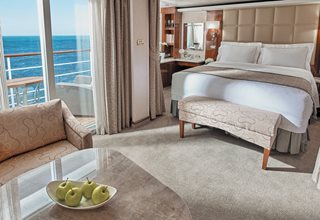
Category: A
The luxurious suite has been carefully designed to maximize space and comfort. Relax on your private balcony and indulge in your lavish bath amenities as you recharge and ready yourself for new adventures in the next port of call. This suite also includes priority online reservations for shore excursions and dining, and you're encouraged to call on the services of a personal butler for special requests.
Suite size: 29.7 m²
Balcony size: 4.7 m²
Amenities:- 1-Night Pre-Cruise Hotel Package Including:
- Ground Transfers
- Breakfast
- Porterage
- Unlimited Wi-Fi Includes up to Four Logins, Four Devices, per Suite
- Valet Laundry Service
- Customizable In-Suite Mini Bar Replenished Daily with Your Preferences
- Welcome Bottle of Champagne and Fresh Fruit
- 24-hour In-Suite Dining
- Fresh Orchid Arrangement
- L'Occitane® Jasmin & Bergamot Bath Amenities
- Regent Plush Bathrobe and Slippers
- Interactive Flat-Screen Television and Direct-Dial Satellite Phone
- Priority Access to Online Shore Excursion Reservations
- Priority Access to Online Dining Reservations
- Binoculars
- illy® Espresso Maker
- Cashmere Blankets
- Regent Special Gift
- Vanity and Hair Dryer
- Shoe Shine Service
- Additional Discounts:
- 10% Discount on Ultra Premium Wine and Liquor
- 5% Savings on Pre- or Post-Cruise Hotel or Land Programs
- 5% Savings on Regent Choice Shore Excursions
- Personal Butler for an Elevated In-Suite Experience
- In-Suite Dining from Compass Rose
- Daily Canapés
- Luxurious Designer Bath Amenities & Men's Unscented Shaving Kit
- Guerlain Bath Amenities & Men's Unscented Shaving Kit
- Bose® SoundLink Mini II Bluetooth Speaker
- Selection of Bed Pillow Styles
- Complimentary Garment Pressing on First Night
- Personalized Stationery upon request
- 1-Night Pre-Cruise Hotel Package Including:

Category: B
The luxurious suite has been carefully designed to maximize space and comfort. Relax on your private balcony and indulge in your lavish bath amenities as you recharge and ready yourself for new adventures in the next port of call. This suite also includes priority online reservations for shore excursions and dining, and you're encouraged to call on the services of a personal butler for special requests.
Suite size: 29.7 m²
Balcony size: 4.7 m²
Amenities:- 1-Night Pre-Cruise Hotel Package Including:
- Ground Transfers
- Breakfast
- Porterage
- Unlimited Wi-Fi Includes up to Four Logins, Four Devices, per Suite
- Valet Laundry Service
- Customizable In-Suite Mini Bar Replenished Daily with Your Preferences
- Welcome Bottle of Champagne and Fresh Fruit
- 24-hour In-Suite Dining
- Fresh Orchid Arrangement
- L'Occitane® Jasmin & Bergamot Bath Amenities
- Regent Plush Bathrobe and Slippers
- Interactive Flat-Screen Television and Direct-Dial Satellite Phone
- Priority Access to Online Shore Excursion Reservations
- Priority Access to Online Dining Reservations
- Binoculars
- illy® Espresso Maker
- Cashmere Blankets
- Regent Special Gift
- Vanity and Hair Dryer
- Shoe Shine Service
- Additional Discounts:
- 10% Discount on Ultra Premium Wine and Liquor
- 5% Savings on Pre- or Post-Cruise Hotel or Land Programs
- 5% Savings on Regent Choice Shore Excursions
- Personal Butler for an Elevated In-Suite Experience
- In-Suite Dining from Compass Rose
- Daily Canapés
- Luxurious Designer Bath Amenities & Men's Unscented Shaving Kit
- Guerlain Bath Amenities & Men's Unscented Shaving Kit
- Bose® SoundLink Mini II Bluetooth Speaker
- Selection of Bed Pillow Styles
- Complimentary Garment Pressing on First Night
- Personalized Stationery upon request
- 1-Night Pre-Cruise Hotel Package Including:

Category: C
The luxurious suite has been carefully designed to maximize space and comfort. Relax on your private balcony and indulge in your lavish bath amenities as you recharge and ready yourself for new adventures in the next port of call. This suite also includes priority online reservations for shore excursions and dining, and you're encouraged to call on the services of a personal butler for special requests.
Suite size: 28.4 m²
Balcony size: 7.4-12.7 m²
Amenities:- 1-Night Pre-Cruise Hotel Package Including:
- Ground Transfers
- Breakfast
- Porterage
- Unlimited Wi-Fi Includes up to Four Logins, Four Devices, per Suite
- Valet Laundry Service
- Customizable In-Suite Mini Bar Replenished Daily with Your Preferences
- Welcome Bottle of Champagne and Fresh Fruit
- 24-hour In-Suite Dining
- Fresh Orchid Arrangement
- L'Occitane® Jasmin & Bergamot Bath Amenities
- Regent Plush Bathrobe and Slippers
- Interactive Flat-Screen Television and Direct-Dial Satellite Phone
- Priority Access to Online Shore Excursion Reservations
- Priority Access to Online Dining Reservations
- Binoculars
- illy® Espresso Maker
- Cashmere Blankets
- Regent Special Gift
- Vanity and Hair Dryer
- Shoe Shine Service
- Additional Discounts:
- 10% Discount on Ultra Premium Wine and Liquor
- 5% Savings on Pre- or Post-Cruise Hotel or Land Programs
- 5% Savings on Regent Choice Shore Excursions
- Personal Butler for an Elevated In-Suite Experience
- In-Suite Dining from Compass Rose
- Daily Canapés
- Luxurious Designer Bath Amenities & Men's Unscented Shaving Kit
- Guerlain Bath Amenities & Men's Unscented Shaving Kit
- Bose® SoundLink Mini II Bluetooth Speaker
- Selection of Bed Pillow Styles
- Complimentary Garment Pressing on First Night
- Personalized Stationery upon request
- 1-Night Pre-Cruise Hotel Package Including:
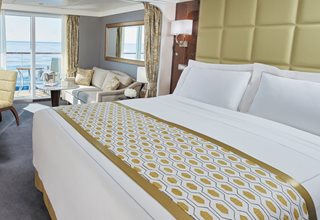
Category: D
In this superbly designed suite, you enjoy the comfort of richly furnished accommodations as well as exclusive luxuries available only in suites at the Concierge level and higher. Your suite includes amenities such as an illy® espresso maker and cashmere blankets, perfect for use in the morning when you wish to sip coffee and enjoy an in-suite breakfast on your private balcony. Take advantage of 24-hour room service when the mood strikes.
Suite size: 28.4 m²
Balcony size: 4.7 m²
Amenities:- 1-Night Pre-Cruise Hotel Package Including:
- Ground Transfers
- Breakfast
- Porterage
- Unlimited Wi-Fi Includes up to Four Logins, Four Devices, per Suite
- Valet Laundry Service
- Customizable In-Suite Mini Bar Replenished Daily with Your Preferences
- Welcome Bottle of Champagne and Fresh Fruit
- 24-hour In-Suite Dining
- Fresh Orchid Arrangement
- L'Occitane® Jasmin & Bergamot Bath Amenities
- Regent Plush Bathrobe and Slippers
- Interactive Flat-Screen Television and Direct-Dial Satellite Phone
- Priority Access to Online Shore Excursion Reservations
- Priority Access to Online Dining Reservations
- Binoculars
- illy® Espresso Maker
- Cashmere Blankets
- Regent Special Gift
- Vanity and Hair Dryer
- Shoe Shine Service
- Additional Discounts:
- 10% Discount on Ultra Premium Wine and Liquor
- 5% Savings on Pre- or Post-Cruise Hotel or Land Programs
- 5% Savings on Regent Choice Shore Excursions
- 1-Night Pre-Cruise Hotel Package Including:

Category: E
In this superbly designed suite, you enjoy the comfort of richly furnished accommodations as well as exclusive luxuries available only in suites at the Concierge level and higher. Your suite includes amenities such as an illy® espresso maker and cashmere blankets, perfect for use in the morning when you wish to sip coffee and enjoy an in-suite breakfast on your private balcony. Take advantage of 24-hour room service when the mood strikes.
Suite size: 28.4 m²
Balcony size: 4.7 m²
Amenities:- 1-Night Pre-Cruise Hotel Package Including:
- Ground Transfers
- Breakfast
- Porterage
- Unlimited Wi-Fi Includes up to Four Logins, Four Devices, per Suite
- Valet Laundry Service
- Customizable In-Suite Mini Bar Replenished Daily with Your Preferences
- Welcome Bottle of Champagne and Fresh Fruit
- 24-hour In-Suite Dining
- Fresh Orchid Arrangement
- L'Occitane® Jasmin & Bergamot Bath Amenities
- Regent Plush Bathrobe and Slippers
- Interactive Flat-Screen Television and Direct-Dial Satellite Phone
- Priority Access to Online Shore Excursion Reservations
- Priority Access to Online Dining Reservations
- Binoculars
- illy® Espresso Maker
- Cashmere Blankets
- Regent Special Gift
- Vanity and Hair Dryer
- Shoe Shine Service
- Additional Discounts:
- 10% Discount on Ultra Premium Wine and Liquor
- 5% Savings on Pre- or Post-Cruise Hotel or Land Programs
- 5% Savings on Regent Choice Shore Excursions
- 1-Night Pre-Cruise Hotel Package Including:
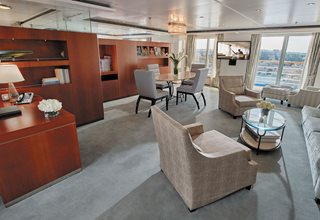
Category: SG
You'll find Park Avenue chic onboard Seven Seas Voyager® in this spectacular suite. Elegant rosewood furniture, luxe fabrics and a crystal chandelier create sophisticated comfort, while a personal butler is available to fulfill whatever requests you may have. With two bedrooms, two-and-a-half baths, a large living room and two private balconies, this sublime suite is perfect for hosting new friends in luxury.
Suite size: 107.0-113.0 m²
Balcony size: 17.0-17.4 m²
Amenities:- 1-Night Pre-Cruise Hotel Package Including:
- Ground Transfers
- Breakfast
- Porterage
- Unlimited Wi-Fi and Streaming Package for up to Four Devices
- Valet Laundry Service
- 24-hour In-Suite Dining
- Fresh Orchid Arrangement
- L'Occitane® Jasmin & Bergamot Bath Amenities
- Regent Plush Bathrobe and Slippers
- Interactive Flat-Screen Television and Direct-Dial Satellite Phone
- Priority Access to Online Shore Excursion Reservations
- Priority Access to Online Dining Reservations
- Binoculars
- illy® Espresso Maker
- Cashmere Blankets
- Regent Special Gift
- Vanity and Hair Dryer
- Shoe Shine Service
- Additional Discounts:
- 10% Discount on Ultra Premium Wine and Liquor
- 5% Savings on Pre- or Post-Cruise Hotel or Land Programs
- 5% Savings on Regent Choice Shore Excursions
- VIP Status Including Dinner with a Senior Officer
- Guaranteed Reservation Each Night in Specialty Restaurant of Your Choice
- Welcome Letter from the President and General Manager
- Personal Butler for an Elevated In-Suite Experience
- In-Suite Dining Menu Including Specialty Restaurant Selections During Dining Hours
- Priority Boarding on Embarkation Day with Suite Access at Noon
- Welcome Bottle of Premium Champagne
- Personalized In-Suite Full-Liquor Bar Set-Up
- A Sumptuous In-Suite Caviar Service Once During Cruises
- Complimentary In-Suite Cocktail Party for 8
- Complimentary 25-Minute Personal Fitness Session at the Serene Spa & Wellness™ Fitness Center
- Delivery of up to 3 Daily Newspapers and World Atlas
- Daily Canapés
- Tea Forté Set-Up
- Luxe Fruit Arrangement with Chocolate Leonidas
- Luxurious Designer Bath Amenities & Men's Unscented Shaving Kit
- Guerlain Box with Fragrance & Spongellé Buffer
- Hair dryer
- Selection of Fig and Tea Leaves Bath Salts
- Guerlain Bath Amenities & Men's Unscented Shaving Kit
- Bath Scale Setup
- Bose® SoundLink Mini II Bluetooth Speaker
- Selection of Bed Pillow Styles
- Complimentary Garment Pressing on First Night
- Personalized Stationery upon request
- Elegant Weather Clock
- Excursion Bag
- 1-Night Pre-Cruise Hotel Package Including:
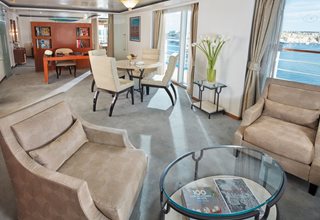
Category: GS
A suite so large it has two entrances, this suite delights the senses with rich mosaics, exotic woods and luxurious touches. A living area with a couch and two comfortable chairs, a full dining table and large writing table make you feel right at home. A large private balcony lets you welcome friends for a quiet dinner, and a personal butler helps make life at sea a breeze.
Suite size: 70 m²
Balcony size: 11.4 m²
Amenities:- 1-Night Pre-Cruise Hotel Package Including:
- Ground Transfers
- Breakfast
- Porterage
- Unlimited Wi-Fi Includes up to Four Logins, Four Devices, per Suite
- Valet Laundry Service
- 24-hour In-Suite Dining
- Fresh Orchid Arrangement
- L'Occitane® Jasmin & Bergamot Bath Amenities
- Regent Plush Bathrobe and Slippers
- Interactive Flat-Screen Television and Direct-Dial Satellite Phone
- Priority Access to Online Shore Excursion Reservations
- Priority Access to Online Dining Reservations
- Binoculars
- illy® Espresso Maker
- Cashmere Blankets
- Regent Special Gift
- Vanity and Hair Dryer
- Shoe Shine Service
- Additional Discounts:
- 10% Discount on Ultra Premium Wine and Liquor
- 5% Savings on Pre- or Post-Cruise Hotel or Land Programs
- 5% Savings on Regent Choice Shore Excursions
- VIP Status Including Dinner with a Senior Officer
- Guaranteed Reservation Each Night in Specialty Restaurant of Your Choice
- Welcome Letter from the President and General Manager
- Personal Butler for an Elevated In-Suite Experience
- In-Suite Dining Menu Including Specialty Restaurant Selections During Dining Hours
- Priority Boarding on Embarkation Day with Suite Access at Noon
- Welcome Bottle of Premium Champagne
- Personalized In-Suite Full-Liquor Bar Set-Up
- A Sumptuous In-Suite Caviar Service Once During Cruises
- Complimentary In-Suite Cocktail Party for 8
- Complimentary 25-Minute Personal Fitness Session at the Serene Spa & Wellness™ Fitness Center
- Delivery of up to 3 Daily Newspapers and World Atlas
- Daily Canapés
- Tea Forté Set-Up
- Luxe Fruit Arrangement with Chocolate Leonidas
- Luxurious Designer Bath Amenities & Men's Unscented Shaving Kit
- Guerlain Box with Fragrance & Spongellé Buffer
- Hair dryer
- Selection of Fig and Tea Leaves Bath Salts
- Guerlain Bath Amenities & Men's Unscented Shaving Kit
- Bath Scale Setup
- Bose® SoundLink Mini II Bluetooth Speaker
- Selection of Bed Pillow Styles
- Complimentary Garment Pressing on First Night
- Personalized Stationery upon request
- Elegant Weather Clock
- Excursion Bag
- 1-Night Pre-Cruise Hotel Package Including:
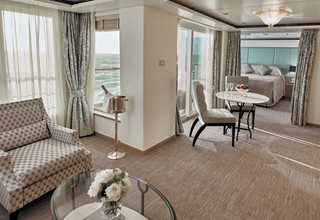
Category: VS
Treat yourself to the welcoming luxury of a suite where elegance and comfort beckon in every nook. Open the sliding doors to your private balcony and inhale the fresh sea air. Enjoy your morning coffee at a cozy dining table or put your feet up in a soothing living room. Call on the services of a personal butler to assist with any needs and ensure that each moment of your journey exceeds your expectations.
Suite size: 51.5 m²
Balcony size: 4.7 m²
Amenities:- 1-Night Pre-Cruise Hotel Package Including:
- Ground Transfers
- Breakfast
- Porterage
- Unlimited Wi-Fi Includes up to Four Logins, Four Devices, per Suite
- Valet Laundry Service
- 24-hour In-Suite Dining
- Fresh Orchid Arrangement
- L'Occitane® Jasmin & Bergamot Bath Amenities
- Regent Plush Bathrobe and Slippers
- Interactive Flat-Screen Television and Direct-Dial Satellite Phone
- Priority Access to Online Shore Excursion Reservations
- Priority Access to Online Dining Reservations
- Binoculars
- illy® Espresso Maker
- Cashmere Blankets
- Regent Special Gift
- Vanity and Hair Dryer
- Shoe Shine Service
- Additional Discounts:
- 10% Discount on Ultra Premium Wine and Liquor
- 5% Savings on Pre- or Post-Cruise Hotel or Land Programs
- 5% Savings on Regent Choice Shore Excursions
- Welcome Letter from the President and General Manager
- Personal Butler for an Elevated In-Suite Experience
- In-Suite Dining from Compass Rose
- Priority Boarding on Embarkation Day with Suite Access at 1 pm
- Welcome Bottle of Premium Champagne
- Personalized In-Suite Full-Liquor Bar Set-Up
- A Sumptuous In-Suite Caviar Service Once During Cruises
- Delivery of up to 3 Daily Newspapers and World Atlas
- Daily Canapés
- Luxe Fruit Arrangement
- Luxurious Designer Bath Amenities & Men's Unscented Shaving Kit
- Selection of Fig and Tea Leaves Bath Salts
- Guerlain Bath Amenities & Men's Unscented Shaving Kit
- Bath Scale Setup
- Bose® SoundLink Mini II Bluetooth Speaker
- Selection of Bed Pillow Styles
- Complimentary Garment Pressing on First Night
- Personalized Stationery upon request
- Elegant Weather Clock
- 1-Night Pre-Cruise Hotel Package Including:
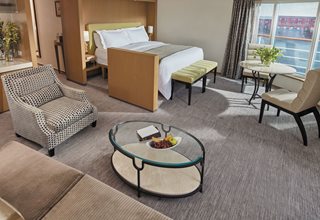
Category: SS
This suite is decorated with soothing colors, pleasing artwork, and comfortable furnishings. Relax in the sitting area after an exciting day ashore and enjoy the selection of fresh canapés delivered by your personal butler. Then retreat to your private balcony to watch the ever-changing vistas. In your glistening bathroom, marvel at the assortment of luxury bath soaps and shampoos as you ponder whether to use your tub or walk-in shower.
Suite size: 36.4-46.0 m²
Balcony size: 4.7-26.3 m²
Amenities:- 1-Night Pre-Cruise Hotel Package Including:
- Ground Transfers
- Breakfast
- Porterage
- Unlimited Wi-Fi Includes up to Four Logins, Four Devices, per Suite
- Valet Laundry Service
- Customizable In-Suite Mini Bar Replenished Daily with Your Preferences
- 24-hour In-Suite Dining
- Fresh Orchid Arrangement
- L'Occitane® Jasmin & Bergamot Bath Amenities
- Regent Plush Bathrobe and Slippers
- Interactive Flat-Screen Television and Direct-Dial Satellite Phone
- Priority Access to Online Shore Excursion Reservations
- Priority Access to Online Dining Reservations
- Binoculars
- illy® Espresso Maker
- Cashmere Blankets
- Regent Special Gift
- Vanity and Hair Dryer
- Shoe Shine Service
- Additional Discounts:
- 10% Discount on Ultra Premium Wine and Liquor
- 5% Savings on Pre- or Post-Cruise Hotel or Land Programs
- 5% Savings on Regent Choice Shore Excursions
- Personal Butler for an Elevated In-Suite Experience
- In-Suite Dining from Compass Rose
- Priority Boarding on Embarkation Day with Suite Access at 1 pm
- Daily Canapés
- Luxe Fruit Arrangement
- Luxurious Designer Bath Amenities & Men's Unscented Shaving Kit
- Selection of Fig and Tea Leaves Bath Salts
- Guerlain Bath Amenities & Men's Unscented Shaving Kit
- Bose® SoundLink Mini II Bluetooth Speaker
- Selection of Bed Pillow Styles
- Complimentary Garment Pressing on First Night
- Personalized Stationery upon request
- Elegant Weather Clock
- 1-Night Pre-Cruise Hotel Package Including:

| Symbol | Description |
|---|---|
 | Three guest capacity suite, convertible sofa bed |
 | Wheelchair accessible suites have shower stall instead of bathtub |
 | Connecting suites |
 | 2-bedroom suite accommodates up to 6 guests |
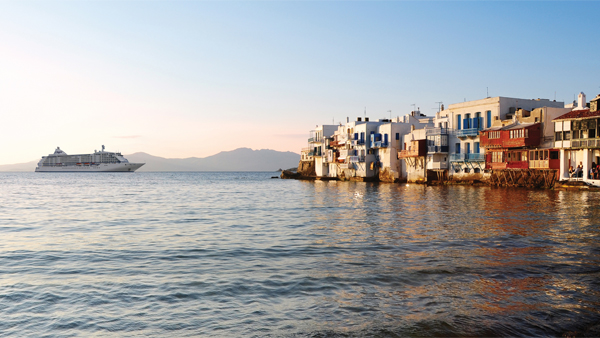
- Ship Name: Seven Seas Voyager
- Year Built: 2003
- Year Refurbished: 2016
- Year Entered Present Fleet: 2008
- Ship Class: Mariner
- Maximum Capacity: 700
- Number of Passenger Decks: 9
- Number of Crew: 447
- Officers' Nationality: International
- Tonnage (GRT): 42,363
- Capacity Based on Double Occupancy: 700
- Country of Registry: The Bahamas
- Total Staterooms: 350
- Suites with Balcony: 350
- Crew/Hotel Staff Nationality: European/International
Costco Member Reviews

Available Dates & Prices
Terms & Conditions
*Price shown is per person based on double occupancy, is valid for select stateroom categories only and does include government taxes/fees and gratuities. Click on the Terms & Conditions link below for details.
**Select complimentary shore excursions are for full-fare guests only, capacity controlled and subject to availability. Shore excursion reservations are accepted on a first-come, first-served basis. Please note, available excursions vary by sailing date and day of the week. Government fees and taxes are included. Requested excursions may not be available at time of booking. Supplement will apply on Regent Choice excursions and excludes Private Arrangements and all Adventures Ashore programs. Restrictions apply and penalties apply 36 hours prior to shore excursion start date.
††All shipboard credit is in U.S. dollars, is per stateroom based on double occupancy, has no cash value, is nontransferable and not redeemable for cash.
†One Digital Costco Shop Card per room/stateroom, per stay. The exact amount of the Digital Costco Shop Card will be calculated during the booking process. The Digital Costco Shop Card promotion is nontransferable and may not be combined with any other promotion. A Digital Costco Shop Card will arrive by email approximately 10 days after the start of your cruise. Click on the Terms & Conditions link below for additional information.
Ship's registry: The Bahamas
Digital Costco Shop Card
Book this vacation or cruise with Costco Travel and receive a Digital Costco Shop Card. The Digital Costco Shop Card is a convenient payment option in our warehouses and on Costco.com.














